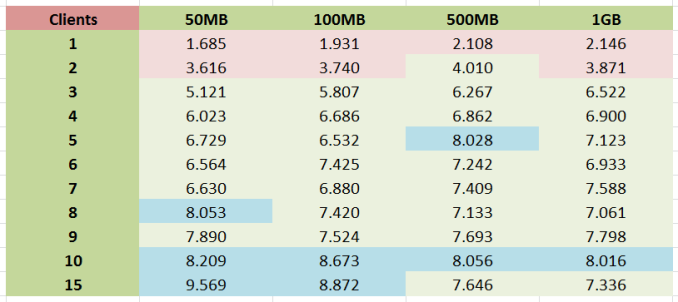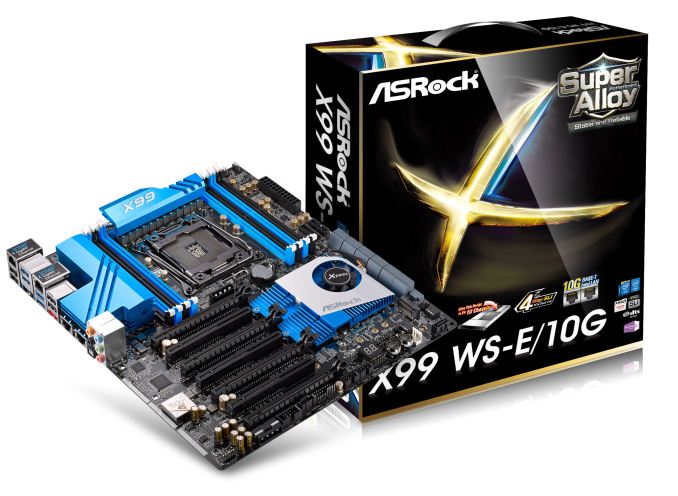ASRock X99 WS-E/10G Motherboard Review: Dual 10GBase-T for Prosumers
by Ian Cutress on December 15, 2014 10:00 AM EST- Posted in
- Motherboards
- IT Computing
- Intel
- ASRock
- Enterprise
- X99
- 10GBase-T
ASRock X99 WS-E/10G Conclusion
One could invite a saying 'the mind wants what the body can't have'. For a number of months and launches, I have wondered why there was a lack of 10GBase-T on consumer motherboards. The simple answer is that the X540 chips, or the Broadcom variants, are not only expensive but also power hungry enough require their own cooling but also require PCIe 2.0 x8 as a recommended minimum. It still baffles me why, despite these issues, it took so long to get on a product.
Our testing however shows the reality of the situation. In a single user point to point transfer, we yielded just over 2.0 Gbps, only 20% of the supposed rating. This was with a 1 GB transfer, with higher sizes increasing the speed up to a point. In order to get more than 2.0 Gbps, we needed to instigate multiple access streams to simulate more than one transfer request. The results pushed us into the 6-8 Gbps range from 4-10 streams and above 8 Gbps for 10+.
This puts a limit on the usefulness for a single individual. It means that the 10GBase-T network interface benefits from individuals that can emulate multiple access streams through software development (bulk information transfer such as MPI or rendering data) or in an SOHO/SMB environment where many users might want to be situated on VMs located on the machine. The motherboard is aimed at the workstation market with support for Xeons and RDIMMs, as well as 1U height clearance for servers too. I can imagine a server or workstation environment using this with several PCIe co-processors attached, each one assigned to a VM and being connected to via the 10G ports.
Due to the price of the controller, ASRock put the 10GBase-T on their highest end motherboard model under the premise that only extreme users will need it. As a result the board is equipped with two PLX8747 chips to allow for x16/x16/x16/x16 operation in a four-way GPU arrangement or x8/x8/x8/x8/x8/x8/x16 when single slot cards are in play. This opens up the market to PCIe coprocessors, RAID card arrangements and FPGA implementation workstations aplenty. Elsewhere on the board are twelve total SATA ports, eight USB 3.0 ports, two Intel I210 GBit ports alongside the two Intel X540-BT2 10Gbit ports, TPM, SATA DOM, M.2 x4 and an enhanced Realtek ALC1150 audio codec solution.
Benchmark results were pretty much ballpark for X99 at stock levels, with multicore turbo putting the CPU results up nearer the top. One disappointing note was the DPC Latency which was reasonable only when the X540 10GBit ports were disabled, suggesting that the combination of 10G drivers and BIOS are not yet optimized for this sort of scenario. However on the plus side POST times were not affected by the X540 controller.
In the end, despite not yet knowing the price of the ASRock X99 WS-E/10G, we can say that it will be expensive. This means possibly in the $700-900 range, due to all the higher end connectivity in play. For that reason alone, the only way this board will be sold is to those that need 10G but also multi-GPU bandwidth. With all that said, I'm still glad ASRock has shown that 10G is possible in the consumer space.












45 Comments
View All Comments
gsvelto - Tuesday, December 16, 2014 - link
Where I worked we had extensive 10G SFP+ deployments with ping latency measured in single-digit µs. The latency numbers you gave are for pure-throughput oriented, low CPU overhead transfers and are obviously unacceptable if your applications are latency sensitive. Obtaining those numbers usually requires tweaking your power-scaling/idle governors as well as kernel offloads. The benefits you get are very significant on a number of loads (e.g. lots of small file over NFS for example) and 10GBase-T can be a lot slower on those workloads. But as I mentioned in my previous post 10GBase-T is not only slower, it's also more expensive, more power hungry and has a minimum physical transfer size of 400 bytes. So if you're load is composed of small packets and you don't have the luxury of aggregating them (because latency matters) then your maximum achievable bandwidth is greatly diminished.shodanshok - Wednesday, December 17, 2014 - link
Sure, packet size play a far bigger role for 10GBase-T then optical (or even copper) SFP+ links.Anyway, the pings tried before were for relatively small IP packets (physical size = 84 bytes), which are way lower then typical packet size.
For message-passing workloads SFP+ is surely a better fit, but for MPI it is generally better to use more latency-oriented protocol stacks (if I don't go wrong, Infiniband use a lightweight protocol stack for this very reason).
Regards.
T2k - Monday, December 15, 2014 - link
Nonsense. CAT6a or even CAT6 would work just fine.Daniel Egger - Monday, December 15, 2014 - link
You're missing the point. Sure Cat.6a would be sufficient (it's hard to find Cat.7 sockets anyway but the cabling used nowadays is mostly Cat.7 specced, not Cat.6a) but the problem is to end up with a properly balanced wiring that is capable of properly establishing such a link. Also copper cabling deteriorates over time so the measurement protocol might not be worth snitch by the time you try to establish a 10GBase-T connection...Cat.6 is only usable with special qualification (TIA-155-A) over short distances.
DCide - Tuesday, December 16, 2014 - link
I don't think T2k's missing the point at all. Those cables will work fine - especially for the target market for this board.You also had a number of other objections a few weeks ago, when this board was announced. Thankfully most of those have already been answered in the excellent posts here. It's indeed quite possible (and practical) to use the full 10GBase-T bandwidth right now, whether making a single transfer between two machines or serving multiple clients. At the time you said this was *very* difficult, implying no one will be able to take advantage of it. Fortunately, ASRock engineers understood the (very attainable) potential better than this. Hopefully now the market will embrace it, and we'll see more boards like this. Then we'll once again see network speeds that can keep up with everyday storage media (at least for a while).
shodanshok - Tuesday, December 16, 2014 - link
You are right, but the familiar RJ45 & cables can be a strong motivation to go with 10GBase-T in some cases. For a quick example: one of our customer bought two Dell 720xd to use as virtualization boxes. The first R720xd is the active one, while the second 720xd is used as hot-standby being constantly synchronized using DRBD. The two boxes are directly connected with a simple Cat 6e cable.As the final customer was in charge to do both the physical installation and the normal hardware maintenance, a familiar networking equipment as RJ45 port and cables were strongly favored by him.
Moreover, it is expected that within 2 die shrinks 10GBase-T controller become cheap/low power enough that they can be integrated pervasively, similar to how 1GBase-T replaced the old 100 Mb standard.
Regards.
DigitalFreak - Monday, December 15, 2014 - link
Don't know why the went with 8 PCI-E lanes for the 10Gig controller. 4 would have been plenty.1 PCI-E 3.0 lane is 1GB per second (x4 = 4GB). 10Gig max is 1.25 GB per second, dual port = 2.5 GB per second. Even with overhead you'd still never saturate an x4 link. Could have used the extra x4 for something else.
The Melon - Monday, December 15, 2014 - link
I personally think it would be a perfect board if they replaced the Intel X540 controller with a Mellanox ConnectX-3 dual QSFP solution so we could choose between FDR IB and 40/10/1Gb Ethernet per port.Either that or simply a version with the same slot layout and drop the Intel X540 chip.
Bottom line though is no matter how they lay it out we will find something to complain about.
Ian Cutress - Tuesday, November 1, 2016 - link
The controller is PCIe 2.0, not PCIe 3.0. You need to use a PCIe 3.0 controller to get PCIe 3.0 speeds.eanazag - Monday, December 15, 2014 - link
I am assuming we are talking about the free ESXi Hypervisor in the test setup.SR-IOV (IOMMU) is not an enabled feature on ESXi with the free license. What this means is that networking is going to tax the CPU more heavily. Citrix Xenserver does support SR-IOV on the free product, which it is all free now - you just pay for support. This is a consideration to base the results of the testing methodology used here.
Another good way to test 10GbE is using iSCSI where the server side is a NAS and the single client is where the disk is attached. The iSCSI LUN (hard drive) needs have something going on with an SSD. It can just be 3 spindle HDDs in RAID 5. You can use disk test software to drive the benchmarking. If you opt to use Xenserver with Windows as the iSCSI client. Have the VM directly connect to the NAS instead of using Xenserver to the iSCSI LUN because you will hit a performance cap from VM to host in the typical add disk within Xen. This is in older 6.2 version. Creedance is not fully out of beta yet. I have done no testing on Creedance and the contained changes are significant to performance.
About two years ago I was working on coming up with the best iSCSI setup for VMs using HDDs in RAID and SSDs as caches. I was using Intel X540-T2's without a switch. I was working with Nexenta Stor and Sun/Oracle Solaris as iSCSI target servers run on physical hardware, Xen, and VMware. I encountered some interesting behavior in all cases. VMware's sub-storage yielded better hard drive performance. I kept running into an artifical performance limit because of the Windows client and how Xen handles the disks it provides. The recommendation was to add the iSCSI disk directly to the VM as the limit wouldn't show up there. VMware still imposed a performance ding on (Hit>10%) my setup. Physical hardware had the best performance for the NAS side.